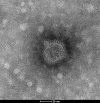Isolation, genetic characterization, and seroprevalence of Adana virus, a novel phlebovirus belonging to the Salehabad virus complex, in Turkey
- PMID: 25653443
- PMCID: PMC4442372
- DOI: 10.1128/JVI.03027-14
Isolation, genetic characterization, and seroprevalence of Adana virus, a novel phlebovirus belonging to the Salehabad virus complex, in Turkey
Abstract
A new phlebovirus, Adana virus, was isolated from a pool of Phlebotomus spp. (Diptera; Psychodidae) in the province of Adana, in the Mediterranean region of Turkey. Genetic analysis based on complete coding of genomic sequences indicated that Adana virus belongs to the Salehabad virus species of the genus Phlebovirus in the family Bunyaviridae. Adana virus is the third virus of the Salehabad virus species for which the complete sequence has been determined. To understand the epidemiology of Adana virus, a seroprevalence study using microneutralization assay was performed to detect the presence of specific antibodies in human and domestic animal sera collected in Adana as well as Mersin province, located 147 km west of Adana. The results demonstrate that the virus is present in both provinces. High seroprevalence rates in goats, sheep, and dogs support intensive exposure to Adana virus in the region, which has not been previously reported for any virus included in the Salehabad serocomplex; however, low seroprevalence rates in humans suggest that Adana virus is not likely to constitute an important public health problem in exposed human populations, but this deserves further studies.
Importance: Until recently, in the genus Phlebovirus, the Salehabad virus species consisted of two viruses: Salehabad virus, isolated from sand flies in Iran, and Arbia virus, isolated from sand flies in Italy. Here we present the isolation and complete genome characterization of the Adana virus, which we propose to be included in the Salehabad virus species. To our knowledge, this is the first report of the isolation and complete genome characterization, from sand flies in Turkey, of a Salehabad virus-related phlebovirus with supporting seropositivity in the Mediterranean, Aegean, and Central Anatolia regions, where phleboviruses have been circulating and causing outbreaks. Salehabad species viruses have generally been considered to be a group of viruses with little medical or veterinary interest. This view deserves to be revisited according to our results, which indicate a high animal infection rate of Adana virus and recent evidence of human infection with Adria virus in Greece.
Copyright © 2015, American Society for Microbiology. All Rights Reserved.
Figures





References
-
- Plyusnin A, Beaty BJ, Elliott RM, Goldbach R, Kormelink R, Lundkvist A, Schmaljohn CS, Tesh RB. 2012. Bunyaviridae, p. 693–709. In King AMQ, Adams MJ, Carstens EB, Lefkowitz EJ (ed),Virus taxonomy: classification and nomenclature of viruses. Ninth report of the International Committee on Taxonomy of Viruses. Elsevier Academic Press, San Diego, CA.
-
- Collao X, Palacios G, de Ory F, Sanbonmatsu S, Pérez-Ruiz M, Navarro JM, Molina R, Hutchison SK, Lipkin WI, Tenorio A, Sánchez-Seco MP. 2010. Granada virus: a natural phlebovirus reassortant of the sandfly fever Naples serocomplex with low seroprevalence in humans. Am J Trop Med Hyg 83:760–765. doi:10.4269/ajtmh.2010.09-0697. - DOI - PMC - PubMed
-
- Zhioua E, Moureau G, Chelbi I, Ninove L, Bichaud L, Derbali M, Champs M, Cherni S, Salez N, Cook S, de Lamballerie X, Charrel RN. 2010. Punique virus, a novel phlebovirus, related to sandfly fever Naples virus, isolated from sandflies collected in Tunisia. J Gen Virol 91:1275–1283. doi:10.1099/vir.0.019240-0. - DOI - PMC - PubMed
Publication types
MeSH terms
LinkOut - more resources
Full Text Sources
Miscellaneous

